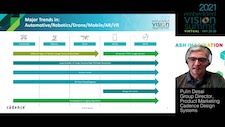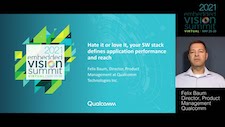| LETTER FROM THE EDITOR |
Dear Colleague,
The next Embedded Vision Summit will take place as a live event from May 17-19, 2022 in Santa Clara, California. The Embedded Vision Summit is the key event for system and application developers who are incorporating computer vision and visual AI into products. It attracts a unique audience of over 1,400 product creators, entrepreneurs and business decision-makers who are creating and using computer vision and visual AI technologies. It’s a unique venue for sharing insights and getting the word out about interesting new technologies, techniques, applications, products and practical breakthroughs in computer vision and visual AI.
We are in the process of creating the program for the 2022 Embedded Vision Summit. If you would like to submit a session proposal, you may do so using the form available here. If you would like to discuss potential topics in advance of submitting a proposal, please contact us at [email protected]. Space is limited, so visit our website today to learn more about the Summit as well as the proposal requirements, and to submit your proposal. We will be accepting proposals through December 6.
Brian Dipert
Editor-In-Chief, Edge AI and Vision Alliance |
| PROCESSOR OPTIONS |
|
For Vision and Edge AI, Are Today’s CPUs Really Old-School?
As AI applications at the edge become pervasive, there’s growing interest in deploying AI on standard hardware platforms such as general-purpose CPUs. But are CPUs sufficient? This roundtable discussion explores the question: Does AI really require GPUs and other special-purpose architectures, or can today’s standard CPUs do the job? Gary Brown, Director of Edge AI Marketing at Intel, AJ Frazer, Vice President of Business Development at Agent Vi, and Sheldon Fernandez, CEO at DarwinAI, look at cutting-edge applications in healthcare and video analytics to take a full-circle view of all the factors—including but not limited to performance—that impact real-world commercialization.
Vision and AI DSPs for Ultra-High-End and Always-On Applications
The number and resolution of image sensors continue to increase in mobile, AR/VR, automotive, drone, mobile, and robotics platforms, which also use a mix of other types of sensors in addition to image sensors. Getting the most from these sensors requires highly programmable, high-performance and low-power vision and AI DSPs. The market also needs different performance points to address various use cases. This presentation from Pulin Desai, Product Marketing Group Director at Cadence Design Systems, highlights trends in these markets and provides an architecture and software overview of the latest additions to the Tensilica Vision and AI DSP product line.
|
| SOFTWARE DEVELOPMENT |
|
From Start to Finish: Build Industrial Embedded Machine Learning Solutions on CPUs and MCUs
In this in-depth tutorial, you’ll learn how to build real-world embedded machine learning applications ranging from simple sensor configurations to powerful Linux-based computer vision applications, hands-on. Aurelien Lequertier, Lead User Success Engineer at Edge Impulse, covers:
- Collecting and classifying datasets
- Designing and training high-accuracy models
- Optimizing and testing your models
- Integrating and shipping with your edge device
The tutorial features step-by-step demonstrations of the concepts discussed. If you choose, you can follow along and perform the steps yourself on a Raspberry Pi 4 and a smartphone.
Hate It Or Love It, Your Neural Network Software Stack Defines Application Performance and Reach
Qualcomm has invested extensively in its state-of-the-art Qualcomm Neural Network software stack, including the Qualcomm Neural Processing SDK and the AI Model Efficiency Toolkit. These toolkits have helped many developers take their applications to the next level with extreme efficiency and performance. In this talk, Felix Baum, Director of Product Management at Qualcomm, explains some of the most common misconceptions related to AI software stacks and frameworks, and how key attributes of these tools, directly and indirectly, impact application performance, the ability of developers with diverse skill levels to use the tools, and the ability to scale applications across processor performance tiers.
|
| UPCOMING INDUSTRY EVENTS |
|
Neuromorphic Sensing and Computing: Compelling Options for a Host of AI Applications – Yole Développement Webinar: November 16, 2021, 9:00 am PT
Developing Intelligent AI Everywhere with BrainChip’s Akida – BrainChip Webinar: December 9, 2021, 9:00 am PT
More Events
|
| FEATURED NEWS |
|
Arm Transforms the Economics of the IoT with Virtual Hardware and a New Solutions-led Offering
Allegro DVT and Beamr Announce a Content-adaptive Silicon IP Video Encoder
Synaptics Announces an AudioSmart Edge AI Headset Platform with Optimized Power and Performance
Hailo Partners with MicroSys to Launch a High Performance Embedded AI Platform
Teledyne DALSA’s 16k Multifield Time Delay Integration Camera Captures Multiple Images in a Single Scan
More News
|
| EDGE AI AND VISION PRODUCT OF THE YEAR WINNER SHOWCASE |
|
Luxonis and OpenCV OpenCV AI Kit with Depth (Best Camera or Sensor)
Luxonis and OpenCV’s OpenCV AI Kit with Depth is the 2021 Edge AI and Vision Product of the Year Award Winner in the Cameras and Sensors category. The OpenCV AI Kit (OAK) is a complete edge AI solution unlike any on the market today, at a price point unmatched in the industry. OAK is the most popular AI-related Kickstarter campaign in history, raising over $1.3 million from 6,500 backers. It is also the basis for the largest AI competition in history, the OpenCV AI Competition 2021 sponsored by Microsoft Azure and Intel, which attracted over 1,200 project submissions from around the world. The OpenCV AI Kit combines the power of the Intel Myriad X Visual Processing Unit with a 4K color camera and HD stereo depth cameras in one single, aluminum-enclosed package, making it suitable for use in practically any environment. OAK is also proudly open source and already supports an ecosystem of devices including versions with on-board Wi-Fi and Bluetooth. And OAK does it all at $149 for the single-camera version and $299 for the OAK-D stereo depth version.
Please see here for more information on Luxonis and OpenCV’s OpenCV AI Kit. The Edge AI and Vision Product of the Year Awards celebrate the innovation of the industry’s leading companies that are developing and enabling the next generation of edge AI and computer vision products. Winning a Product of the Year award recognizes a company’s leadership in edge AI and computer vision as evaluated by independent industry experts. |








